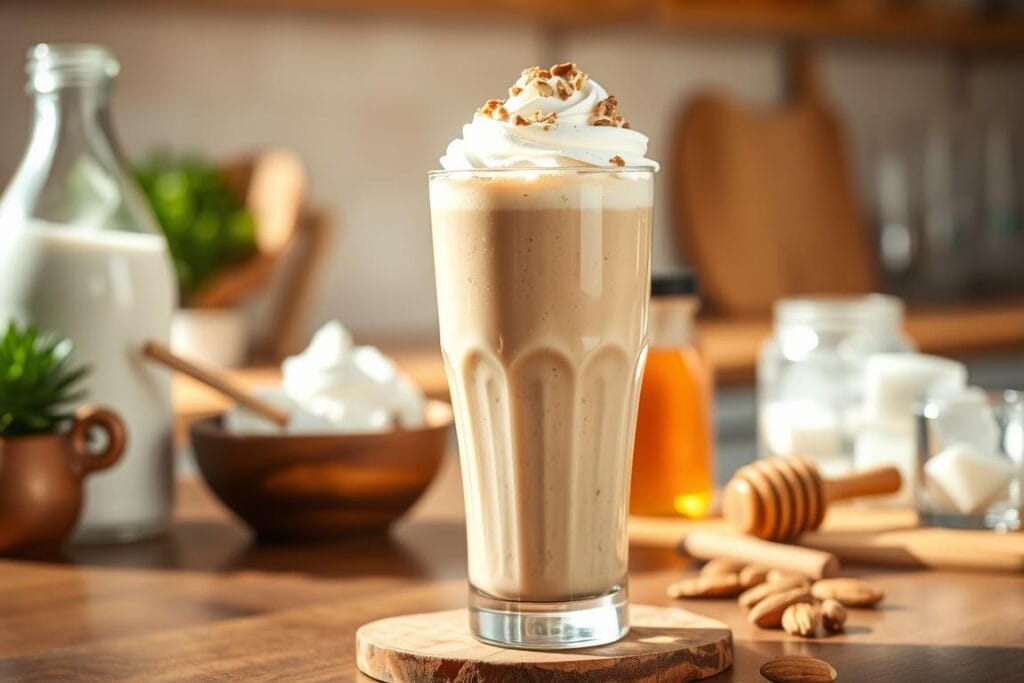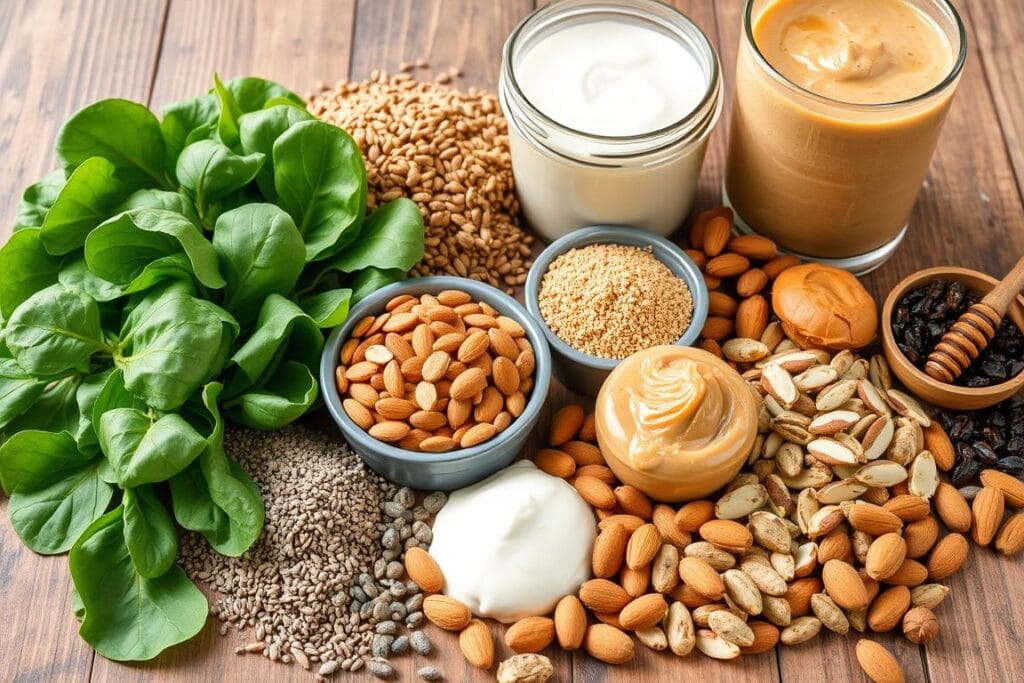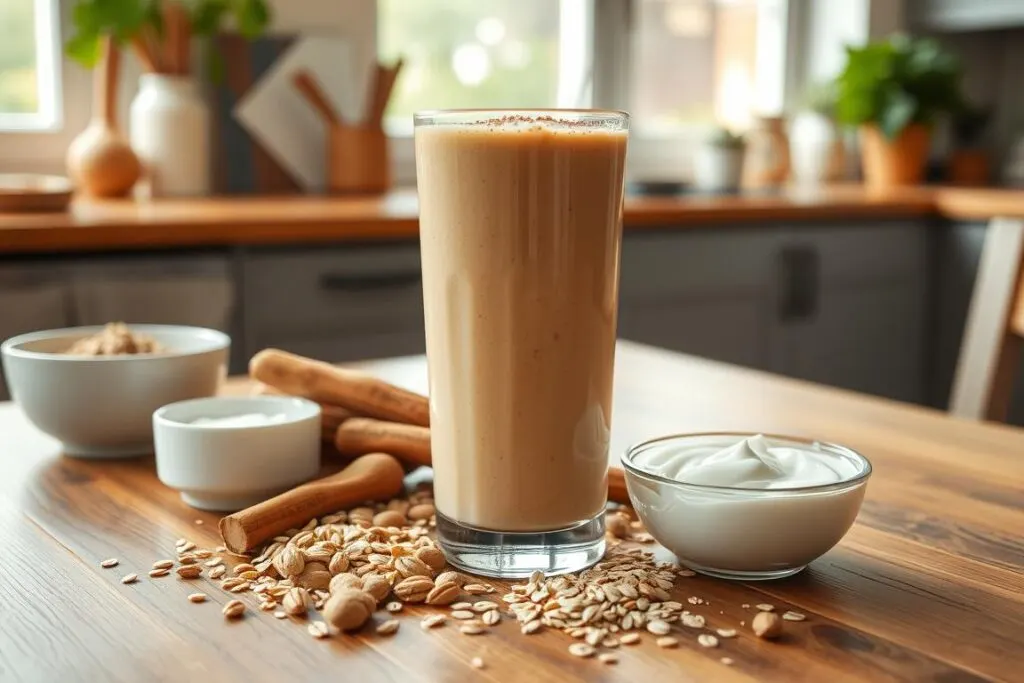Looking for a creamy and nutritious drink without bananas? This peanut butter smoothie without banana is the perfect solution! Packed with protein, healthy fats, and natural flavors, this recipe is ideal for breakfast, a quick snack, or even a post-workout treat. Say goodbye to overly sweet smoothies and hello to a satisfying, banana-free blend!
It’s packed with protein and healthy fats. This makes every sip a delightful experience. Let’s dive into how to make this healthy drink that’s good for you and delicious.

Table of contents
- Understanding the Benefits of a Peanut Butter Smoothie
- Key Ingredients for Your Peanut Butter Smoothie
- How to Make a Peanut Butter Smoothie without Bananas
- How to Thicken Smoothies Without Bananas?
- Creative Variations of Peanut Butter Smoothies
- Peanut Butter Smoothie – Banana-Free Recipe: The Best Proportions
- What to Add for Extra Nutrients?
- Should I Add Milk or Yogurt to a Smoothie?
- Is a Banana Less Healthy in a Smoothie?
- What Does a Peanut Butter Smoothie Do to Your Body?
- FAQ
- Conclusion
Understanding the Benefits of a Peanut Butter Smoothie
A peanut butter smoothie is packed with health benefits. It’s a great way to boost your nutrition without bananas. It’s full of protein and healthy fats, making it perfect for a quick energy boost.
With just a few ingredients, you can make a tasty drink that fits your diet. It’s easy to make and delicious to drink.
High in Protein and Healthy Fats
A peanut butter smoothie is known for its high protein content. This helps you stay full longer. Natural peanut butter has about 8 grams of protein per 2 tablespoons.
Adding whole milk or Greek yogurt increases the protein even more. A cup of whole milk has 8 grams of protein. Adding a scoop of protein powder can add 15 to 25 grams more. This makes it a great choice for breakfast or after working out.
Low Sugar Content
A peanut butter smoothie can be low in sugar if made carefully. Unlike smoothies with lots of fruit, this recipe lets you choose what to add. Omitting sweeteners like honey keeps sugar levels low.
Adding spinach or berries boosts the nutritional value without adding too many calories. This way, you manage sugar intake and get extra vitamins and antioxidants.

In summary, peanut butter smoothies are more than just tasty. They’re full of protein and healthy fats, and low in sugar. They’re great for breakfast, snacks, or even as a meal replacement. This drink can make your day better and improve your nutrition.
| Ingredient | Calories | Protein (grams) |
|---|---|---|
| Peanut Butter (2 tbsp) | 190 | 8 |
| Whole Milk (1 cup) | 150 | 8 |
| Greek Yogurt (1 scoop) | ~100 | 10 |
| Protein Powder (1 scoop) | ~100-150 | 15-25 |
| Honey (1 tbsp) | 64 | 0 |
| Spinach (1 cup) | 7 | 1 |
Key Ingredients for Your Peanut Butter Smoothie
Making a tasty peanut butter smoothie means picking the right ingredients. These should not only taste good but also be healthy. Let’s look at the key ingredients for a great smoothie.
Nutritional Profiles of Ingredients
The main ingredients make your smoothie healthy. Here’s what they bring to the table:
- Peanut Butter: It’s a key part, packed with healthy fats and protein. A quarter cup has about 30g of fat and 17g of protein.
- Milk: You can choose from cow’s milk, almond milk, or oat milk. Each one changes the taste and nutrition.
- Yogurt: Greek yogurt adds creaminess and protein. It also brings probiotics for your gut health.
- Cocoa Powder: It adds flavor and antioxidants. Two tablespoons are a great addition.
- Frozen Ingredients: Frozen fruits or riced cauliflower make the smoothie thick and refreshing.
Choosing the Right Milk or Yogurt
When picking milk options for smoothie, think about what you can eat and what tastes good. Here’s a look at some common choices:
| Milk Option | Calories per cup | Protein (g) | Fat (g) |
|---|---|---|---|
| Cow’s Milk | 146 | 8 | 8 |
| Almond Milk | 30 | 1 | 2.5 |
| Oat Milk | 60 | 2 | 1.5 |
This table shows how different milk options for smoothie change the nutrition. It affects both taste and health benefits. Choosing the right yogurt choices also changes the smoothie’s taste and thickness. Try different combinations to find your favorite.
How to Make a Peanut Butter Smoothie without Bananas
Making a tasty peanut butter smoothie without bananas is easy. Just a few ingredients and simple steps are needed. This guide will show you how to make a smoothie that’s both healthy and delicious, with the perfect consistency.
Step-by-Step Instructions
- Gather your ingredients: 2 tablespoons of peanut butter, 1 cup frozen riced cauliflower, 1 cup almond milk, and optional sweeteners such as 1-3 tablespoons of maple syrup or 1-3 pitted Medjool dates.
- Add ½ cup of raw spinach for enhanced nutrition and not taste.
- Place all ingredients into a blender. If desired, include 2 tablespoons of chia seeds or ½ avocado for additional healthy fats.
- Blend on high until smooth to reach your preferred texture. If it seems too thick, gradually add more almond milk for an optimal consistency.
- Pour into a glass and top with optional mini peanut butter cups or peanuts for added crunch.
Tips for Perfect Consistency
Getting the right smoothie consistency is key. Here are some tips to help:
- Start with less almond milk if you prefer a thicker smoothie, adding more gradually as needed.
- Frozen fruits or vegetables can help create a frosty texture without adding excess sugar.
- Incorporating oats can thicken the smoothie while providing additional fiber.
- Experiment with different ratios until you find what suits your taste best. A balance of ingredients will significantly enhance the overall experience.
How to Thicken Smoothies Without Bananas?
Getting the right smoothie texture can be tricky, and bananas are often a go-to solution. But, there are many ways to thicken your smoothie without bananas. You can use ingredients that make it creamy and nutritious, all without bananas.
Using Oats and Other Thickeners
Oats are a great choice for thickening smoothies. Just a small amount can turn your drink into a creamy treat. Other options include:
- Chia seeds: They soak up water and make your smoothie thick and gel-like.
- Nut butter (like peanut or almond): It adds creaminess and healthy fats.
- Thick yogurt: It makes your smoothie richer and boosts protein.
- Frozen fruits: They not only thicken but also add flavor.
Using frozen fruit instead of ice makes your smoothie creamier. A weak blender works better with frozen fruit than ice, giving you a smoother blend.
Vegetable Options for Creaminess
Vegetables can also make your smoothie creamy, without bananas. Try adding:
- Avocado: Its healthy fats make it rich.
- Spinach: It’s packed with nutrients and blends well.
- Zucchini: Its high water content adds creaminess without changing the taste.
For a refreshing change, try kefir instead of water. It’s tangy like yogurt. If your smoothie is too thick, add milk, kefir, or coconut milk. But be careful not to dilute it too much.
| Thickener | Effect on Texture | Nutrition Benefits |
|---|---|---|
| Oats | Gives body and creaminess | High in fiber |
| Chia Seeds | Thickens when hydrated | Rich in omega-3 fatty acids |
| Nut Butter | Creamy and rich | Healthy fats and protein boost |
| Avocado | Silky texture | Good source of healthy fats |
| Frozen Fruits | Helps thicken, adds flavor | High in vitamins |
Blending slowly for a longer time can reduce foam. Strain through a fine-mesh sieve to get rid of grit. Making smoothies your own way is fun and allows for endless experimentation.
Creative Variations of Peanut Butter Smoothies
Discover a world of flavors with creative peanut butter smoothie variations. You can turn your regular smoothie into exciting new recipes. Try the chocolate peanut butter smoothie or the strawberry smoothie without banana for a unique taste. Both are packed with protein.
Chocolate Peanut Butter Smoothie
Chocolate lovers will adore the chocolate peanut butter smoothie. It combines rich, creamy textures with delicious flavors. Add a tablespoon of cocoa powder to your classic smoothie for a chocolate twist. Here’s what you need:
- 1 cup unsweetened almond milk
- 1-2 tablespoons peanut butter or peanut butter powder
- 1 scoop of unflavored or chocolate protein powder
- 2 tablespoons cocoa powder
- Ice cubes or coffee cubes for added texture
- Optional drizzle of honey for sweetness
This smoothie is not only tasty but also boosts your energy with over 25 grams of protein per serving.
Strawberry Peanut Butter Smoothie Without Banana
For a fruity twist, try the strawberry smoothie without banana. Frozen strawberries give it a refreshing taste without bananas. Here’s a simple recipe:
- 1 cup unsweetened almond milk
- 1-2 tablespoons peanut butter or peanut butter powder
- 1 cup frozen strawberries
- 1 scoop vanilla protein powder
- Ice cubes, if desired
This smoothie is not only tasty but also meets the demand for banana-free smoothies. About 65% of smoothie fans prefer this option.
Try these variations to get creative in the kitchen. You can add your favorite fruits or even greens for more nutrients. The possibilities are endless!
Peanut Butter Smoothie – Banana-Free Recipe: The Best Proportions
Making a tasty peanut butter smoothie without bananas is all about the right mix. Finding the perfect balance of ingredients can make your smoothie creamy and flavorful. You’ll learn how to make your smoothie just right, with the right amounts of everything.
Ideal Ratios of Ingredients
For a smoothie that’s both creamy and delicious, try these ratios:
| Ingredient | Amount |
|---|---|
| Frozen fruit (mixed berries) | 1 cup |
| Liquid (almond milk) | ¼ cup |
| Peanut butter | 1½ Tbsp, melted |
| Chia seeds (optional) | ½ Tbsp |
These ratios will give you a smoothie full of nutrients. You’ll get about 278 calories, 6 grams of protein, and 11 grams of healthy fats. Feel free to tweak these amounts to suit your taste and what you have on hand.
Personalizing Your Smoothie
To make your smoothie even better, add your own twist. Here are some ideas:
- Add a scoop of protein powder for more protein.
- Try different milks like oat or coconut milk for a unique taste.
- Superfoods like spirulina or acai can add extra health benefits.
- Use honey, maple syrup, or stevia to adjust the sweetness.
- Top it with granola, nuts, or seeds for extra texture and nutrition.
These tips let you make a peanut butter smoothie that’s just right for you. With the right mix and a bit of personal touch, you’ll have a smoothie that’s both healthy and delicious every time.
What to Add for Extra Nutrients?
To make your peanut butter smoothie even better, try adding different ingredients. These can include healthy fats, vitamins, and flavor enhancers. This not only makes your smoothie healthier but also tastier. Here’s how to do it right.
Seeds and Healthy Fats
Adding seeds to your smoothie can make it thicker and more nutritious. They’re full of omega-3 fatty acids and fiber. Here are some great options:
- Chia Seeds – One tablespoon is full of fiber and helps with digestion.
- Flaxseeds – Ground flaxseeds add omega-3s and antioxidants to your smoothie.
- Hemp Seeds – These seeds are rich in protein and healthy fats, making them perfect for a nutrient boost.
Choosing natural nut butters like almond or peanut butter adds healthy fats. They make your smoothie creamy and increase the protein.
Fruit Bits and Flavor Enhancers
Adding fruit bits like berries, mango, or avocado makes your smoothie taste better. It also increases the vitamin content. These fruits add antioxidants and sweetness without too much sugar. For even more flavor without sugar, try these:
- Cinnamon – A little cinnamon adds flavor and has anti-inflammatory benefits.
- Vanilla Extract – A small amount adds sweetness and depth without extra calories.
- Cacao Powder – It gives a chocolatey flavor and is full of antioxidants.
Using these ingredients is a great way to add nutrients to your smoothies. They keep your smoothies delicious and fulfilling.

Should I Add Milk or Yogurt to a Smoothie?
Choosing between milk or yogurt in your peanut butter smoothie is key. Each has its own benefits and drawbacks. Knowing how they affect your smoothie can help you make the best choice.
Pros and Cons of Each Option
Milk and yogurt each have their own pluses and minuses:
- Milk:
- It makes your smoothie creamy and smooth.
- It has a good mix of carbs and proteins, with about 8 grams of protein per cup.
- Plant-based milks have less protein, which can lower your smoothie’s protein.
- Yogurt:
- It adds about 26 grams of protein per serving, great for muscle recovery.
- It’s thicker than milk, making your smoothie more filling.
- It often has probiotics, which are good for your gut.
How They Affect Texture and Flavor
Choosing milk or yogurt changes your smoothie’s texture and taste. Milk makes it lighter and creamier. Yogurt makes it thicker and tangier. It also changes the nutritional value:
| Component | Milk | Yogurt |
|---|---|---|
| Protein (per cup) | 8g | 26g |
| Calories (per cup) | 103 | 150 |
| Texture | Smooth | Thick |
| Flavor Profile | Mild | Tangy |
Your choice depends on what you like and need. For a creamier, lighter smoothie, pick milk. For a thicker, protein-rich one, choose yogurt.
Is a Banana Less Healthy in a Smoothie?
Thinking about adding bananas to your smoothies? It’s key to look at their health benefits and compare them to other options. Bananas are sweet naturally and don’t have added sugars. But, some might wonder if they’re better off without bananas. Knowing the calorie and nutrient differences can help you decide.
Caloric and Nutritional Comparison
Let’s compare bananas in smoothies to a banana-free option. Here’s a nutritional breakdown:
| Ingredient | Calories | Carbs (g) | Protein (g) | Fat (g) | Fiber (g) | Sugar (g) |
|---|---|---|---|---|---|---|
| Banana Smoothie (1 serving) | 324 | 43 | 12 | 14 | 9 | 18 |
| Smoothie without Banana (1 serving) | 163 | 29 | 3 | 5 | 6 | 17 |
The banana smoothie has more calories but more protein and fiber too. On the other hand, the banana-free smoothie has fewer calories, which is good for those watching their intake. Both options offer a range of nutrients, making it easy to choose based on your diet.
Common Misconceptions about Bananas in Smoothies
There’s a myth about bananas being too sugary. But, their natural sugars are different from added sugars. Bananas add nutrients like potassium, Vitamin C, and fiber to smoothies. Some think smoothies without bananas are healthier, but both can be good depending on what you add.
It’s important to look at the big picture of your diet, not just one ingredient. The idea that bananas are always bad is not true.
What Does a Peanut Butter Smoothie Do to Your Body?
A peanut butter smoothie is packed with health benefits. It’s creamy and fills you up, giving you energy all day. With peanut butter, you get protein, healthy fats, and nutrients that boost your health.
Health Benefits of Peanut Butter
Peanut butter is full of good stuff. It has 16 grams of healthy fats in every two-tablespoon serving. Most of these fats are good for your heart. It also has 15 to 25 grams of protein, helping your muscles.
Plus, it has about 3.5 grams of fiber, which is great for your digestion. Eating it regularly can make your diet more nutritious. It’s also good for gaining weight.
Impact on Energy Levels and Satiety
The healthy fats and protein in a peanut butter smoothie give you a big energy boost. It’s perfect for breakfast or after working out. The fiber in it helps you feel full longer.
This can help you eat less during the day. Feeling full longer can also help you stick to your diet. It leads to healthier eating habits.
FAQ
To thicken smoothies without bananas, try adding oats, chia seeds, or avocados. These ingredients make the smoothie creamy and enhance its texture.
A peanut butter smoothie is packed with protein and healthy fats. It boosts your energy and keeps you full. It’s great for muscle recovery and overall health.
Whether to use milk or yogurt is up to you. Milk makes smoothies creamy and light. Yogurt adds protein and thickness. Both can improve the taste.
Bananas have more sugar than some fruits. While they’re nutritious, choosing lower-sugar fruits can be better for those watching their sugar intake.
Yes! Mix peanut butter, milk (dairy or non-dairy), and a sweetener like honey or maple syrup. It’s a quick and tasty smoothie.
Use avocado or oats as a thickener. Add peanut butter and milk. Adjust the sweetness to your liking.
Yes! Blend frozen strawberries, peanut butter, and milk. It’s a delicious strawberry peanut butter smoothie without banana.
Conclusion
Peanut butter smoothies without bananas offer big health benefits. They mix healthy fats, protein, and fiber well. This makes them a great choice for keeping energy up without too much sugar.
Each ingredient adds something special, letting you make a smoothie that’s just right for you. You can change things up to fit your taste and diet needs.
Adding a peanut butter smoothie to your day can boost your nutrition. It’s also a tasty way to replace a meal or snack. Try mixing different sugars and proteins to make your own unique smoothie.
These drinks are perfect for a quick breakfast or a mid-day boost. The benefits of peanut butter smoothies are clear. They’re delicious and good for you. So, go ahead and try one out. Your taste buds and body will love it!

